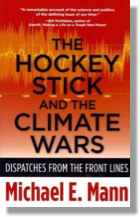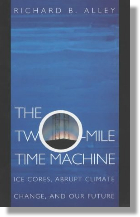|
* Apple users running MacOSX 10.4 or later must
install Microsoft's Silverlight software in order to view the streaming videos marked with *.
Once installed, restart your browser before viewing.
Silverlight 4.0 intel (14MB) |
Silverlight 1.0 ppc (5MB)

WATCH
AND
LISTEN |
shorter |
How Reliable Are Satellite Temperatures?
Peter Sinclair, interviewing Andrew Dessler
A very clear explanation of how we know what we know from satellite and other
kinds of temperature measurements. Satellite data needs a lot of work to
interpret!
(9 minutes, January 2016)
How We Know Increased CO2 is Coming from Humans
Lee Kump and Peter Sinclair
Part of a series of videos made by Peter Sinclair, this interview with a
geochemist offers a very clear explanation of how different versions
(isotopes) of carbon in the air can be identified as coming from particular
kinds of sources. This "fingerprinting" allows scientists to tell which carbon
comes from, say, deforestation or volcanoes, and which comes from fossilized
plant material, aka coal, oil, and gas.
(2 minutes, August 2015)
How We Learned about Greenland Melting
Jason Box and Peter Sinclair
The accelerating melting of Greenland's ice is a very important process to
understand, and this pair of explanations is an excellent start. Glaciologist
Jason Box explains in a column from the Huffington Post, and film-maker Peter
Sinclair illustrates with a video from the Dark Snow Project and Yale Climate
Connections.
(7 minutes, August 2015)
The Emergent Patterns of Climate Change
Gavin Schmidt, Ted Talk
This is an excellent talk (by a leading scientist in the field) about how
climate models work and what they are best at telling us. If you aren't clear
on this subject, start here!
(12 minutes, March 2014)
Climate Change: Lines of Evidence
National Academies of Sciences
If you're not sure exactly how scientists know humans (not the sun, natural
cycles, or volcanoes) are responsible for current warming, these clips are
clear primers. They add up to just under half an hour, but on YouTube they
are in short bits. There is an online, downloadable booklet, too.
(2-6 minutes, 2012)
How a General Circulation Model is Put Together
low-res |
high-res
National Center for Atmospheric Research
A quick, clear summary of how computer climate models are constructed, from
one of the world's leading centers for this kind of research.
(2 minutes, 2012)
Dendrochronology and Climate
low-res stream |
med-res stream |
QuickTime movie
Peter Brown, Rocky Mountain Tree Ring Research
What is dendrochronology, how are tree rings measured, and what does any of
it have to do with understanding the earth's climate? In this short clip,
dendrochronologist Brown takes us through his process and shows us how much
we can learn from the trees around us.
(7 minutes, February 2010)
Greenland Ice Cores from Science Nation (NSF)
Jim White, Institute of Arctic and Alpine Research
Ice-core scientist Jim White talks about what and how Greenland ice tells us
about past climates (including the rapid changes at the end of the
last ice age)‒and why this information is important.
(5 minutes, July 2009)
To What Degree? What Science Is Telling Us About Climate Change
National Science Foundation, Science 360
Lots of videos of leading scientists talking about how we know the climate is
changing, the IPCC, the carbon and water cycles, the planet's heat balance,
climate modeling, what Americans believe about this subject, and the history
of climate research, with the promise of more to come. The videos are broken
into very short bites, each a lively, pithy response to a single question.
(various lengths)
|
| |
longer |
Why We Should Believe in Science
Naomi Oreskes, Ted Talk, May 2014
Very interesting talk by science historian Oreskes, who talks us through the
question of why we should trust science. Perhaps especially useful for
non-scientists who aren't sure scientific information is any different from
other matters of belief or personal opinion, but also interesting for
scientists in what she says about the so-called scientific method.
(19 minutes, May 2014)
|
| READ |
books |
 The Hockey Stick and the Climate Wars: Dispatches from the Front Lines
The Hockey Stick and the Climate Wars: Dispatches from the Front Lines
Michael Mann. Columbia University Press, 2012, 395pp.
Highly readable and informative, Mann's book tells two interlocking stories:
how his part of climate science works‒how he and his colleagues came to
know what they know‒and how the political attacks on this science, and
these scientists, unfolded. The second story is the more dramatic, and
certainly important for any concerned citizen to know; but the first is also
quite interesting, probably especially for nonscientist readers.
 The Two-Mile Time Machine: Ice Cores, Abrupt Climate Change, and Our Future
The Two-Mile Time Machine: Ice Cores, Abrupt Climate Change, and Our Future
Richard Alley. Princeton University Press, 2000, 229pp.
For a clear explanation of how scientists interpret ice cores for climate
history information, see chapters 4-8 (pages 31-79). The accompanying notes
(pages 203-209) point to additional and more technical sources.
|
| |
articles & essays |
Explainer: How "Shared Socioeconomic Pathways Explore Future Climate Change"
CarbonBrief, April 2018
If you have ever wondered how the SSPs (Shared Socioeconomic Pathways), or
possible future scenarios, are constructed, this piece will fill you in. This
is useful knowledge for understanding many "official" reports, and it can
help us think about what future we want to create.
Analysis: Why Scientists Think 100% of Global Warming Is Due to Humans
Zeke Hausfather, CarbonBrief, December 2017
A very lucid and helpful explainer, with readable graphs. Best guesses as to
how much of global warming is human-caused? Loosely speaking: all of it, and
then some, since natural factors would have us cooling. More technically;
IPCC, 72% to 146%; fourth US National Climate Assessment, 93% to 123%. This
article makes sense of such numbers.
Science Is Already Political, So Scientists Might as Well March
David Roberts, Vox.com, April 2017
This is a very interesting meditation on how science has two
selves‒theoretical science and practiced science. The powerful idea of
the first has nothing to do with getting out in the streets, but the
pragmatics of the second does. Makes a nice complement to the video by Naomi
Oreskes above. The somewhat misleading title reflects the debates rising from
the 2017 worldwide March for Science.
How Climate Change Could Jam the World's Ocean Circulation
Nicola Jones, Yale e360, September 2016
This is a good primer on how the North Atlantic ocean (and heat) circulation
system works, focused on how scientists are currently working to figure out
what might be happening to that critically important system.
Here Is What Happens When You Try to Replicate Climate Contrarian Papers
Dana Nuccitelli, The Guardian, August 2015
What does one have to do to repeat the results of the very small number of
papers at odds with the overwhelming consensus that current climate change is
human caused? In one case: ignore 6,000 years of data and keep only 4,000
years. A very useful article describing such a project.
Extreme Weather in a Changing Climate: Asking the Right Questions
Laura Snider, NCAR/UCAR AtmosNews, June 2015
How do we know whether a particular weather event is linked to climate change?
It depends on what questions we ask‒and we may have been asking the
wrong ones. This is a clear, enlightening summary of an article by Keven
Trenberth, John Fasullo, and Theodore Shepherd published in Nature Climate
Change.
Ocean Acidification, Now Watchable in Real Time
Brian Kahn, Climate Central, February 2015
A brief, interesting account of a new monitoring tool that combines numerous
sources of information (including satellites) about a variety of ocean
conditions to help scientists watch hotspots for such things as stress on
coral reefs. Includes an animation of changes from 2010 to 2014.
Holocene Temperatures
RealClimate, March 2013
A very interesting Q&A by the authors of a study published in Science that
reconstructed the temperature record of the last eleven thousand years.
Technical but clear, with good links for those who wish to read more.
How High Could the Tide Go?
Justin Gillis, New York Times, January 2013
How high has sea level risen in the past, when CO2 levels were about the same
as they'll be very soon? And how might we figure this out? A scientific team
led by Columbia University scientist Maureen Raymo is working to find and
understand fossil beaches from one such period, the Pliocene, rough three
million years ago. This lively and informative article is part of the
excellent "Temperature Rising" series.
|
| |
websites |
Climate Feedback
This website "organizes scientists from around the world to comment on the
accuracy of a variety of climate change media articles . . . Scientists'
comments, or 'annotations' are layered directly onto the original texts . . .
Climate Feedback assigns each article a 'credibility' rating based on the
annotations and evaluations made by the participating scientists, giving
readers an overall guide to the accuracy of the text."
These are media articles scientists have called overly alarmist.
Here
is the full list of reviews.
The Discovery of Global Warming
Spencer Weart
Physicist and prominent science historian Weart offers a good miscellany of
sources on this site, which expands on his readable and informative book by
the same name (Harvard University Press, 2008, 2nd edition), a history of
"how scientists came to (partly) understand what people are doing to cause
climate change." Includes numerous additional essays about the history of
climate change science and scientists, as well as links and bibliographies.
|
|
|



